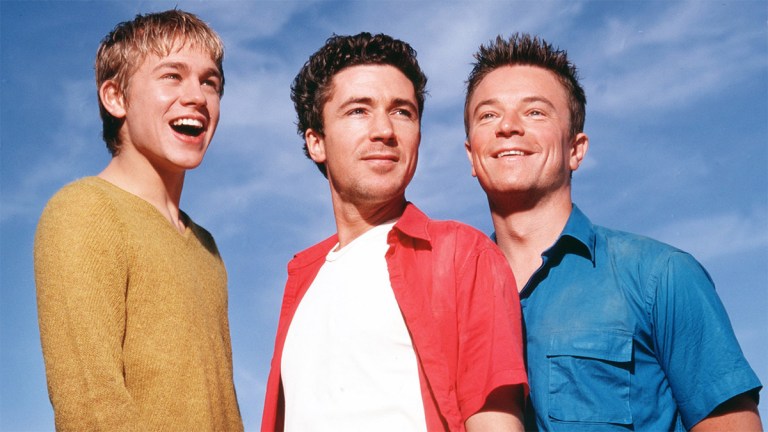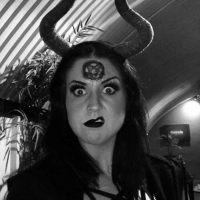Rediscovering Queer As Folk: The Groundbreaking UK Series Years Ahead of its Time
Doctor Who showrunner Russell T Davies’ Queer As Folk sparked a second US remake this year. Here’s where it all started, with the original Channel 4 drama that deserves a second look.

Warning: this article contains some explicit language.
In 1999, Channel 4 premiered a short-lived comedy drama chronicling the lives of three young gay men in Manchester. Queer as Folk, in typical Channel 4 fashion, wasn’t a show that teetered on the edge of social acceptability, it hit screens with all the subtlety of a queen’s grand entrance on RuPaul’s Drag Race and a resounding chant of ‘we’re here, we’re queer, get used to it’. Even gay people switched on the TV and were shocked. Nobody had seen such a candid and explicit expression of homosexuality on television. As i journalist Hugh Montgomery recalls “Having just turned 16, and back from school for half-term, I sat in the family living room, remote control in hand, ready to flick the channel at any moment should my parents walk in.” And numerous others can attest, no doubt, that the titillating no-holds-barred look at gay life in the ’90s, whether you were gay or not, held a certain level of thrill for its unapologetic approach. But that wasn’t all the show had to offer, its themes of friendship, unrequited love, the monotony of bar-hopping and singlehood, teenage angst and living outside the status quo have an enduring appeal that most of us can relate to.
Centred around three young men: Vince (Craig Kelly), Stuart (Aidan Gillen) and Nathan (Charlie Hunnam), the show was a unique look at the gay scene from the get-go, and from the point of view of someone who had been immersed in it. They say ‘write what you know’ and showrunner Russell T Davies did just that. The result is heart-warming, sometimes heart-wrenching, and wickedly funny. Speaking to The Guardian in 2015, Davies says of the main characters, “they’re very different: Stuart is the cocky, sexually confident one; Vince a bit less sure of himself; and Nathan, who’s 15, is just starting out. But they’re also three versions of the same man. All of us have been those people at one time or another.” And that’s the crux of it. Whether you identify as gay, straight, bi or anything in between, whether you are male or female, trans or non-binary, we all have elements of each of them – or perhaps wish we did.
Queer As Folk caused instant controversy upon release thanks to its graphic portrayals of gay sex, and shockingly not for the fact that a 29-year-old adult “pulls” a 15-year-old school student (an aspect changed in the US version, increasing his age to 17) in the very first episode – which, by today’s standards, is the most problematic aspect of the show.
Actor Aidan Gillen told The Guardian in 2015: “For a programme filmed in the late 1990s it was pretty full-on, sexually. There was a famous scene where I showed Charlie Hunnam, who played Nathan, what rimming was all about. Filming that took a lot of trust.
“But the sex was an essential part of the character and the drama, and I always saw it as a story of empowerment. In the past 15 years I’ve met a lot of people – men and women – who said Queer as Folk helped them get their confidence. I’m pretty proud of that.”
Even today its scenes of naked, sweaty men, buns-bared, are a little shocking. While it might be commonplace to see female nudity, straight sex-scenes and even girl-on-girl action, men shagging men just isn’t quite so acceptable on mainstream television, and this was especially true twenty-odd years ago. But the way in which the sexual interactions are portrayed in the show is nothing short of liberating. There is no slut shaming, it’s all just experiences, and a part of growing up, getting to know yourself better. Nathan, played by Charlie Hunnam, springs to life after his sexual encounter with Stuart. It’s a learning curve and initiation into the gay scene where he is able to find himself and develop his own identity.
Another reason the show made an impact, and still holds up today, is its politics. When fifteen year old Nathan roars at his high school bestie, “Donna, you don’t know her! You don’t know anything! Cos you’re straight! Right? You’re part of the system! Right? You’re part of the fascist heterosexual orthodoxy!” It wasn’t the sort of political notion you’d hear on TV. And Donna’s response is even more spectacular: “I’m Black. And I’m a girl. Try that for a week.” Aiden Gillen commented that upon reading the script, he was “just impressed by its in-your-faceness. I’d never read a TV script that was so bold.” And Queer As Folk’s social awareness is leaps and bounds ahead of its contemporaries.
Casual racism, sexism and homophobia was commonplace in the media in 1999 and mostly only explicitly criticised through the medium of stand-up comedy and sketch shows. It’s almost easy to forget how much things have changed since Queer As Folk first aired. Gay marriage was just a pipe-dream and it was only 14 years prior to the show’s premiere that UK TV had seen its first openly gay character in the form of Gordan Collins in the soap Brookside. The same series had featured the first same-sex kiss on UK television in 1994, and it was brief, to say the least, but sparked outrage nonetheless. The king of queer himself, Elton John, hadn’t officially “come out” as a gay man until a 1992 interview with Rolling Stone magazine. Just take a look at the decade-defining US TV show Friends. While it might have shown one of the first lesbian weddings, it is full of problematic instances that just helped to perpetuate existing stereotypes and warped thinking.
And it wasn’t just in the media. “Gay” was a commonly used as slang by British kids as a term for lousy. Feminism had become a dirty word and feminists were often defined as man-haters. In 2005, the UK first legalised same-sex civil partnerships but it wasn’t until 2014 that gay marriage was legal. Yet, within the last decade since, the whole landscape has changed. Now, there is a whole new generation rejecting social norms, gender roles and challenging the cultural status quo. Growing up post-internet and social media, with access to everything and anything at the click of a button, they are questioning the societal values that were often brushed off at the time. Feminism is no longer a dirty word and Black Lives Matter is pushing for further change in terms of racial discrimination. It’s a fertile ground for a brand new incarnation of the show that broke boundaries and first places homosexuals at the helm of an entire series.
Russell T Davies, of course, faced a ton of backlash – and not just from homophobes. Davies was criticised at the time for appearing to ignore the 1980s AIDS crisis, which was apparently unacceptable if you were producing a television show about gay sex. But this was the new millennium, the AIDS crisis wasn’t the “gay disease” anymore, a harmful narrative that needs to remain in the ’80s along with mullets and over-sized shoulder pads. Why was it always gay people who have to be haunted by an epidemic that affected hundreds upon thousands of people, whether queer or not? Besides, it could have run the risk of stigmatising the epidemic yet again, for a new generation.
Queer As Folk, as Hugh Montgomery so eloquently puts it, is “aspirational not cautionary”. Gay people needed to be portrayed in a positive light, they needed to see characters onscreen who seemingly had it all. Nathan, the teenager fulfilling his hormone-fuelled dreams and being accepted into the gay club scene; Vince, the one who acclimatises to hetero culture so convincingly he attracts more attention from women than men (a bizarre aspiration, but perhaps one that young gay men hoped for in order to avoid unwanted attention and prejudice); and Stuart, the one who is unashamedly gay and proud of it. Interestingly, Stuart is also the only one who is still closeted to his parents until the end.
In 2021, Davies finally addressed the initial QAF criticism that it ignored the HIV/AIDS epidemic, in the form of Channel 4’s streaming service All4’s most binge-watched series, It’s a Sin. Set in the 1980s, the drama directly deals with the impact the AIDS has on its characters. The series received eleven British Academy Television Awards nominations, making it 2022’s most nominated show as well as inviting critical acclaim for Davies’ writing and the cast’s stunningly honest portrayals. It also shed new light on the experience of the epidemic, through stories of those who were affected the most – the gay community – as well as encouraging a rise in HIV testing in the young people of today.
Another issue critics had with QAF was its so-called stereotyping. The characters are, in some ways, archetypes. The tongue-in-cheek nature of the show lends itself to cliches. And while self-absorbed Stuart is a little caricature-esque, a show isn’t half as entertaining without a deeply flawed anti-hero. While he’s stuck in a selfish, repetitive loop of bar-hopping and superficial one-night-stands, he’s also incredibly likable. He’s very loyal and is often the only character who will actively stand up against discrimination, with little concern for his own well-being or repercussions.
Besides, we all know someone like Stuart, who is stuck in this cycle, no matter their gender or sexuality. Perhaps he’s a little stereotypical of the age-old conventions of what society deems a gay man, but in so many other ways, Queer As Folk avoids the stereotyping. None of the men are camp nor are they dressed head-to-toe in designer gear. Similarly, none of the lesbian characters suffer from pigeonholing either.
This is not to say that Queer As Folk is without flaws – there’s body shaming and instances of prejudice of course. And let’s not forget the elephant in the room: the statutory rape of Nathan.
There’s no doubt that Queer as Folk was important, love it or hate it. It gave young homosexuals representation on mainstream television – and not just representation but central focus for the first time. But many of the themes are universal. Nathan’s awkward coming of age and trying to find his way sexually, is relatable to all of us. His obsession with Stuart following his first sexual encounter is cringeworthy but oh so spot on – we’ve all had those teenage crushes that caused us to act foolishly, whatever your sexual orientation.
If its social impact doesn’t convince you to give the original a watch (or rewatch), Queer As Folk is unapologetically honest and funny. Ultimately, we implore you to binge-watch Queer As Folk for its overarching message to be yourself. Whatever that might be and no matter who that might disappoint.
